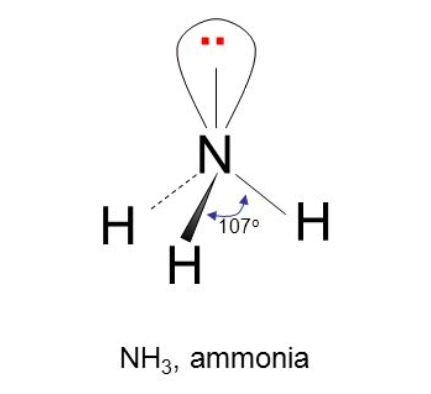
Why is the $H-O-H$ bond angle in ${{H}_{2}}O$ is smaller than the $H-N-H$ bond angle in $N{{H}_{3}}$?
Answer
566.1k+ views
Hint: The concept of intermixing of different atomic orbitals in which the energy is redistributed to give the new orbitals having symmetrical orientation in shape and equivalent energy of the orbitals. The new orbitals which are formed are known as the hybrid orbitals and this process is known as hybridization.
Complete step by step answer:
The theory which helps us to predict the shape and hybridization of the molecule is the valence shell electron pair repulsion theory or the VSEPR theory. Some important points of this theory:
The paired electrons which are present in the valence shell of the central atom is known as lone pair and the unpaired electrons form a bond with the unpaired electrons of other surrounding atoms known as bond pairs.
There are three types of repulsions in the molecule lone pair – lone pair repulsion, lone pair – bond pair repulsion and bond pair- bond pair repulsion.
The order of magnitude for the repulsive force is
Lone pair – lone pair is greater than lone pair- bond pair which is greater than bond pair –bond pair
Both water and ammonia molecules have $s{{p}^{3}}$ hybridization and the expected shape of both water and ammonia is tetrahedral.
Structure of $N{{H}_{3}}$

From the above structure
Number of lone pair=1
Number of bond pair=3
Structure of ${{H}_{2}}O$

From the above structure
Number of lone pair=2
Number of bond pair=2
Hence there is more lone pair – lone pair repulsion in water molecule as compare to ammonia, that’s why the$H-O-H$ bond angle in ${{H}_{2}}O$ is smaller than the $H-N-H$ bond angle in $N{{H}_{3}}$.
Note: One of the limitations of the VSEPR theory is that the bond angle deviation. This theory predicts molecular geometry but we cannot predict the shape of the transition metal compound using the VSEPR theory.
Complete step by step answer:
The theory which helps us to predict the shape and hybridization of the molecule is the valence shell electron pair repulsion theory or the VSEPR theory. Some important points of this theory:
The paired electrons which are present in the valence shell of the central atom is known as lone pair and the unpaired electrons form a bond with the unpaired electrons of other surrounding atoms known as bond pairs.
There are three types of repulsions in the molecule lone pair – lone pair repulsion, lone pair – bond pair repulsion and bond pair- bond pair repulsion.
The order of magnitude for the repulsive force is
Lone pair – lone pair is greater than lone pair- bond pair which is greater than bond pair –bond pair
Both water and ammonia molecules have $s{{p}^{3}}$ hybridization and the expected shape of both water and ammonia is tetrahedral.
Structure of $N{{H}_{3}}$

From the above structure
Number of lone pair=1
Number of bond pair=3
Structure of ${{H}_{2}}O$

From the above structure
Number of lone pair=2
Number of bond pair=2
Hence there is more lone pair – lone pair repulsion in water molecule as compare to ammonia, that’s why the$H-O-H$ bond angle in ${{H}_{2}}O$ is smaller than the $H-N-H$ bond angle in $N{{H}_{3}}$.
Note: One of the limitations of the VSEPR theory is that the bond angle deviation. This theory predicts molecular geometry but we cannot predict the shape of the transition metal compound using the VSEPR theory.
Recently Updated Pages
Master Class 12 Business Studies: Engaging Questions & Answers for Success

Master Class 12 Economics: Engaging Questions & Answers for Success

Master Class 12 English: Engaging Questions & Answers for Success

Master Class 12 Maths: Engaging Questions & Answers for Success

Master Class 12 Social Science: Engaging Questions & Answers for Success

Master Class 12 Chemistry: Engaging Questions & Answers for Success

Trending doubts
What is meant by exothermic and endothermic reactions class 11 chemistry CBSE

Which animal has three hearts class 11 biology CBSE

10 examples of friction in our daily life

One Metric ton is equal to kg A 10000 B 1000 C 100 class 11 physics CBSE

1 Quintal is equal to a 110 kg b 10 kg c 100kg d 1000 class 11 physics CBSE

Difference Between Prokaryotic Cells and Eukaryotic Cells




